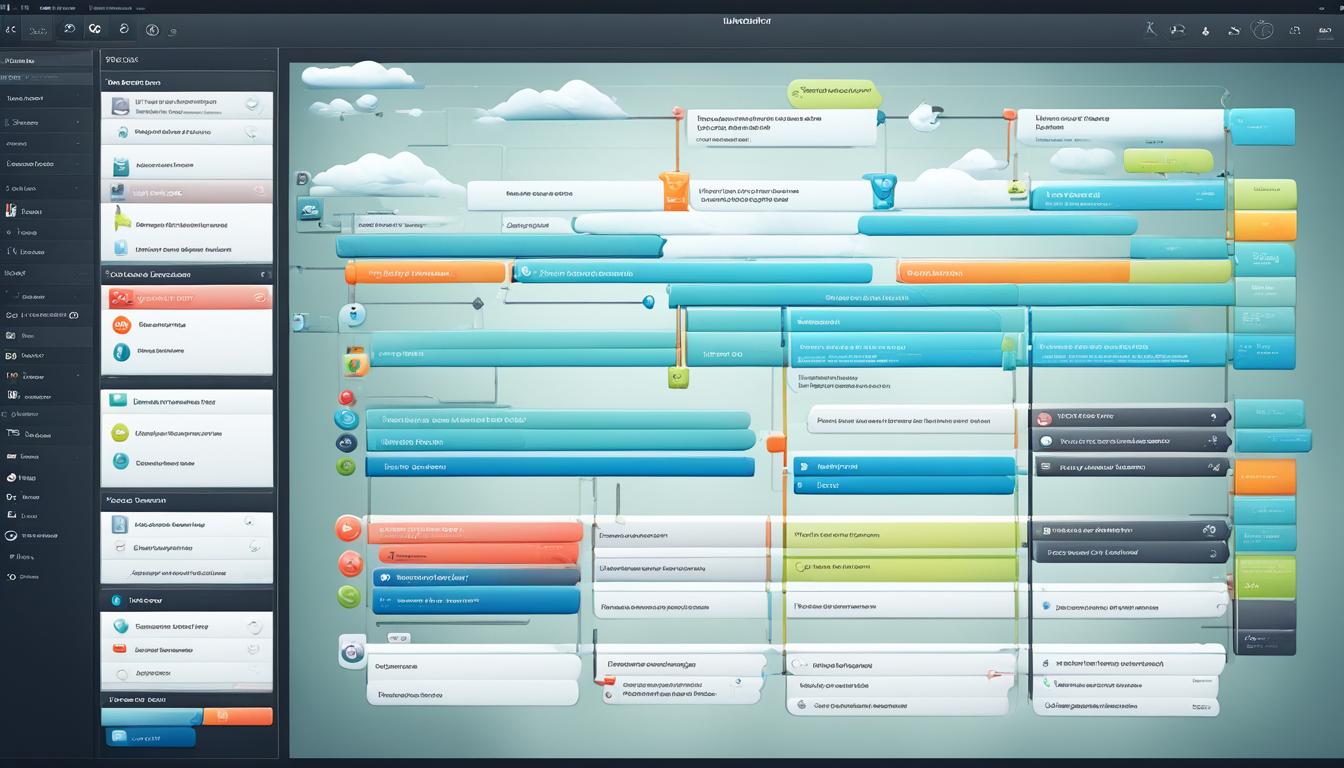Have you ever wondered how businesses successfully optimize their workflow management? Is there a secret tool that helps them achieve optimal efficiency and productivity? Well, the answer lies in the power of process design software.
Process design software is not just another fancy application. It is a game-changer that revolutionizes the way businesses manage their workflows. With its advanced features and capabilities, this software takes workflow automation to a whole new level.
Let’s dive into the world of process design software and uncover how it can transform your business operations. But first, let me entice you with three intriguing statistics:
1. According to a study by McKinsey, organizations that implement workflow automation software experience a 20% increase in productivity and a 30% reduction in operational costs.
2. A report by PricewaterhouseCoopers (PwC) found that using a business process management platform can improve process efficiency by up to 30%.
3. Research conducted by the International Data Corporation (IDC) shows that companies that embrace digital process design solutions achieve a staggering 200% return on investment (ROI).
Understanding Clash Detection in BIM for Effective Workflow Streamlining
Clash detection plays a crucial role in the Building Information Modeling (BIM) process, allowing businesses to identify and resolve conflicts within 3D models. By proactively detecting clashes early in the design phase, businesses can prevent construction errors and delays, resulting in significant cost and time savings.
Collaboration is key to successful clash detection. By fostering collaboration among stakeholders, including architects, engineers, and contractors, businesses can ensure that clashes are addressed in a timely manner. This collaborative approach promotes effective communication and enables adjustments to be made when they are more manageable and cost-effective.
Automated clash reports are essential for efficient workflow streamlining. These reports provide detailed information about clashes, highlighting the specific areas that need attention. With the help of these reports, businesses can prioritize and address clashes promptly, minimizing the risk of errors and ensuring the smooth progression of the project.
Regular model updates are another vital strategy for clash detection and workflow optimization. By continually updating the 3D model and running clash detection analyses, businesses can stay ahead of potential clashes throughout the project lifecycle. This proactive approach reduces the need for rework and avoids costly delays.

| Benefits of Clash Detection in BIM | Key Factors |
|---|---|
| Precise clash identification | Early detection of clashes |
| Cost and time savings | Collaboration among stakeholders |
| Reduced construction errors | Regular model updates |
Clash detection in BIM software is a game-changer for effective workflow streamlining. By leveraging collaboration, early detection, automated clash reports, and regular model updates, businesses can ensure the successful completion of projects while minimizing costly errors and delays.
Enhancing Workflow Management with Visual Workflow Design Software
When it comes to managing workflows, visual representation is key. That’s where workflow design software comes in. With its ability to simplify complex tasks and automate processes, this software has revolutionized workflow management. By utilizing visual representations like flowcharts and flow diagrams, businesses can gain a clearer understanding of their processes and identify areas for improvement.
One of the major advantages of workflow design software is its automation capabilities. Tasks that were once tedious and time-consuming can now be streamlined and executed with just a few clicks. This not only saves time but also helps eliminate human error. With the ability to assign tasks to specific team members and track their progress, workflow design software ensures that everyone is on the same page and working towards a common goal.
Collaboration is another key feature of workflow design software. With the ability to share workflows and collaborate in real-time, team members can work together more efficiently. This leads to better communication, improved coordination, and increased productivity.
Whether you’re creating workflows from scratch or customizing pre-built templates, workflow design software offers flexibility to suit your specific needs. You have the freedom to design workflows that align with your organization’s unique processes and requirements.
Workflow design software provides businesses with the tools they need to visualize their tasks and processes, automate workflows, and collaborate effectively. By adopting this software, organizations can enhance their workflow management, optimize productivity, and achieve greater success.
Example Real-Time Collaboration Workflow:
| Task | Assigned To | Status |
|---|---|---|
| Create initial design | Jane | In progress |
| Review design | John | Completed |
| Make revisions | Jane | Not started |
| Approve final design | Manager | Not started |
As you can see in the example above, workflow design software allows for real-time collaboration and provides a clear overview of each task’s status. This improves communication, reduces delays, and ensures that everyone is on track.
With the visual representation, automation capabilities, and collaboration features offered by workflow design software, businesses can streamline their processes, enhance productivity, and achieve better results. It’s time to take your workflow management to the next level with this powerful tool.
Assemplify: Revolutionizing Workflow Management for Commercial Furniture Projects
When it comes to managing workflow in the commercial furniture industry, there’s a new player in town that is changing the game. Assemplify, developed by K-Optional Software and designed by McSwain, is an innovative platform designed specifically for commercial furniture projects. With its advanced features and user-friendly interface, Assemplify is revolutionizing workflow management in this industry.
One of the standout features of Assemplify is its real-time job tracking functionality. This allows project managers and team members to have a clear and up-to-date view of the progress and status of each task. With real-time tracking, delays and bottlenecks can be quickly identified, allowing for proactive solutions and timely adjustments. Assemplify ensures that everyone involved in the project is on the same page and can make informed decisions to keep the workflow running smoothly.
Another key feature of Assemplify is its text message notification system. Team members can receive instant updates and alerts right on their mobile devices, keeping them informed even when they’re on the move. This quick and efficient communication ensures that tasks are completed promptly, potential issues are addressed promptly, and deadlines are met without any delays.
Smooth workflow management also means seamless payment integration. Assemplify offers a convenient payment system that allows for easy invoicing and payment processing. With this integrated feature, businesses can streamline their financial processes, reducing the administrative burden and ensuring quick and hassle-free payments.
The benefits of Assemplify for commercial furniture projects
Assemplify’s automation capabilities are a game changer for commercial furniture projects. Manual and repetitive tasks are automated, freeing up valuable time and resources, and eliminating the risk of human errors. This automation not only improves efficiency but also allows team members to focus on high-value tasks that require their expertise and creativity.
Moreover, Assemplify’s user-friendly interface makes it easy for everyone to navigate and utilize the platform effectively. This ensures smooth adoption and minimal learning curve, allowing teams to get up and running quickly without any disruptions to their workflow. With Assemplify, even those with minimal technical skills can easily manage and contribute to the project, fostering collaboration and maximizing productivity.

In conclusion, Assemplify is transforming workflow management in the commercial furniture industry. With its real-time tracking, text message notifications, seamless payment integration, and automation capabilities, it offers a comprehensive solution for streamlining projects and empowering teams. By leveraging Assemplify’s innovative features and user-friendly interface, businesses can optimize their workflows, improve collaboration, and achieve success in their commercial furniture projects.
| Key Features of Assemplify | Benefits |
|---|---|
| Real-time job tracking | Efficient progress monitoring and proactive issue resolution |
| Text message notifications | Instant updates for prompt response and timely actions |
| Seamless payment integration | Effortless invoicing and smooth financial processes |
| Automation capabilities | Elimination of manual tasks and reduction of human errors |
| User-friendly interface | Quick adoption, minimal learning curve, and enhanced collaboration |
Conclusion
Process design software is the ultimate solution for businesses seeking to optimize their workflows and boost productivity. With features like clash detection, visual workflow design, and automation, this software streamlines processes and fosters seamless collaboration among team members.
Whether you’re in the construction industry utilizing BIM software or managing commercial furniture projects with platforms like Assemplify, process design software offers a wide range of benefits. From process optimization to industrial process simulation, this software is a valuable asset for businesses across various industries.
By leveraging the power of process design software, businesses can enhance workflow management, simplify task visualization, and automate processes, resulting in optimal efficiency and success. Whether it’s finding the right process optimization tool, process mapping tool, digital process design solution, industrial process simulation software, or enterprise process modeling software, investing in process design software is an indispensable step towards achieving organizational goals.
FAQ
What is process design software?
Process design software is a powerful tool that helps businesses streamline their workflows by automating processes and optimizing task management.
How does process design software enhance efficiency?
Process design software enhances efficiency by automating repetitive tasks, providing workflow visualization, and integrating with project management tools to optimize operations.
What is clash detection in BIM?
Clash detection in BIM refers to the identification and resolution of conflicts within a 3D model to prevent construction errors and delays.
Why is early clash detection important?
Early clash detection allows businesses to address conflicts and make adjustments when they are more manageable and cost-effective, minimizing errors and delays.
What is visual workflow design software?
Visual workflow design software utilizes flowcharts and flow diagrams to simplify complex tasks and automate processes, making task and process management more efficient.
How does visual workflow design software improve workflow management?
Visual workflow design software provides transparency, accuracy, and productivity benefits by offering task assignments, different workflow types, and collaboration capabilities.
What is Assemplify?
Assemplify is a revolutionary workflow management platform designed specifically for commercial furniture projects, offering real-time job tracking, text message notifications, and seamless payment integration.
How does Assemplify revolutionize workflow management?
Assemplify revolutionizes workflow management by automating tasks, facilitating collaboration among teams, and providing a user-friendly interface for efficient and collaborative work processes.
What are the benefits of process design software?
Process design software offers a range of benefits including process optimization, workflow automation, task visualization, and industrial process simulation for improved efficiency and success.





